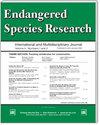通过参与式科学方法对印度东部奇利卡泻湖中受全球威胁的渔猫 Prionailurus viverrinus 的密度进行估计
IF 2.9
2区 环境科学与生态学
Q2 BIODIVERSITY CONSERVATION
引用次数: 0
摘要
摘要:渔猫(Prionailurus viverrinus)是一种依赖印度-马拉亚湿地的猫科动物,在世界自然保护联盟红色名录中被列为易危物种。它的主要猎物鱼类对能量的需求很低,而且在富饶的水生栖息地中数量很多。这有利于提高食鱼动物的密度,并有可能改变将种群密度与小型猫科动物体重联系起来的预期比例模式。在当地社区的参与下,我们估算了位于印度东部奥迪沙邦的亚洲最大咸水湖奇利卡的渔猫密度。这项研究在 2021 年和 2022 年期间分两个阶段在不同的栖息地进行:一个是同质的沼泽栖息地及其缓冲区(北部区块),另一个是不同土地利用类型的异质矩阵(南部区块)。我们共布设了 144 个照相陷阱,历时 4380 个陷阱夜。利用空间明确捕获-再捕获(SECR)技术,我们估计北部区块的平均(±SE)渔猫密度为 0.69 ± 0.1 ind. km-2,南部区块为 0.67 ± 0.33 ind. km-2。北部区块和南部区块的种群丰度估计值分别为 159 ± 23 和 185 ± 91。在前者,SECR建模表明人为生境改变对该物种的家园范围产生了影响。我们的密度估计值是该物种在保护区外的最高估计值之一。研究结果表明,奇利卡拥有丰富的渔猫种群,要使其继续生存下去,就必须缓解当地和外部对鱼类种群的威胁。此外,我们的研究采用了包容性的方法,为使用相机诱捕法获得湿地栖息地中具有独特标记个体的物种的可靠密度估计值开创了先例。本文章由计算机程序翻译,如有差异,请以英文原文为准。
Density estimation of the globally threatened fishing cat Prionailurus viverrinus through a participatory science approach in the Chilika lagoon, eastern India
ABSTRACT: The fishing cat Prionailurus viverrinus is an Indo-Malayan wetland-dependent felid which is listed as Vulnerable on the IUCN Red List. Its main prey, fish, has low energetic demands and is abundant in productive aquatic habitats. This facilitates high piscivore densities and potentially alters expected scaling patterns that link population density to the body mass of small cats. With local community participation, we estimated the density of the fishing cat in Chilika, Asia’s largest brackish water lagoon, located in the state of Odisha, eastern India, with community participation. The study was carried out in 2 phases in different habitats during 2021 and 2022: a homogeneous marshy habitat and its buffer (Northern Block), and a heterogeneous matrix of different land-use types (Southern Block). We deployed a total of 144 camera traps across 4380 trap nights. Using spatially explicit capture-recapture (SECR), we estimated mean (±SE) fishing cat density to be 0.69 ± 0.1 ind. km-2 in the Northern Block and 0.67 ± 0.33 ind. km-2 in the Southern Block. The population abundance estimates for the Northern and the Southern Blocks were 159 ± 23 and 185 ± 91 respectively. In the former, SECR modelling indicated an effect of anthropogenic habitat modification upon the species’ home range extent. Our density estimates are amongst the highest reported for the species outside protected areas. The results imply that Chilika holds an abundant population of the fishing cat, the continued persistence of which requires mitigation of local and external threats to fish populations. Furthermore, our study, with its inclusive approach, sets a precedent for the use of camera trapping for obtaining robust density estimates of species with uniquely marked individuals in wetland habitats.
求助全文
通过发布文献求助,成功后即可免费获取论文全文。
去求助
来源期刊

Endangered Species Research
BIODIVERSITY CONSERVATION-
CiteScore
5.50
自引率
6.50%
发文量
38
审稿时长
31 weeks
期刊介绍:
ESR is international and interdisciplinary. It covers all endangered forms of life on Earth, the threats faced by species and their habitats and the necessary steps that must be undertaken to ensure their conservation. ESR publishes high quality contributions reporting research on all species (and habitats) of conservation concern, whether they be classified as Near Threatened or Threatened (Endangered or Vulnerable) by the International Union for the Conservation of Nature and Natural Resources (IUCN) or highlighted as part of national or regional conservation strategies. Submissions on all aspects of conservation science are welcome.
 求助内容:
求助内容: 应助结果提醒方式:
应助结果提醒方式:


